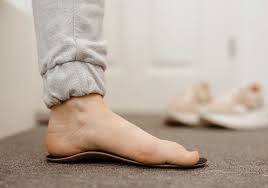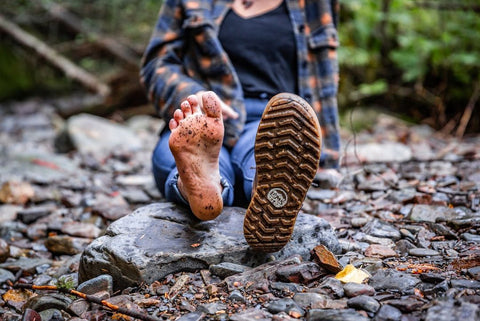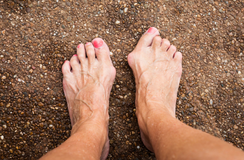As the world is slowly discovering the benefits that barefoot shoes can provide for one’s feet, more and more people will find themselves asking whether this type of footwear is meant for them. In that same breath, a common but still very valid question is whether or not flat feet and barefoot shoes are a good mix.
To better answer this question, it helps to learn more about what flat feet are, as well as what barefoot shoes (or natural/minimalist footwear) can do for your feet. Read on
What are Flat Feet?

Known medically as Pes Planus, flat foot is a deformity that's more common than you'd think. It is when the inner arches of your feet fall, and come into contact with the ground. With this condition, your feet roll inward as you put weight on them in each step. This occurrence is known as overpronation, and contributes to flat feet.
Flat feet are caused due to the muscles in the arches of your feet weakening, typically caused due to aging or injuries. This, however, can also happen to young and healthy individuals, including teenagers. While it may never really cause serious injury on its own, this condition can lead to issues later on in life. Particularly due to the loss of muscle strength in the feet which, in turn, leads to pain, and makes you more prone to sprains.
The Correlation Between Arch Supports and Flat Feet

As a child, your feet are naturally flat. With growth and use of your feet (without any supports), the foot muscles begin to develop without hindrance. This development is important since it leads to a strong, raised arch in your feet. Unfortunately, things start to go wrong when toddlers or children who are just learning how to walk, are dressed in footwear with raised heels, thicker soles, and even arch supports.
For anyone who uses regular, supported shoes, especially while their feet are still growing and developing, weak feet (as they get older) are pretty much a given. The fact is that those who have become accustomed to supportive footwear even before their arches form, often end up with foot pain and other foot-related problems. This support in shoes is designed to hold the arch of your feet up, thereby reducing any discomfort you may feel along a fallen arch. Since this also reduces the stress those muscles feel, they tend to relax more and, in turn, limits their usage and engagement, causing further weakening of the feet.
As this happens, you begin to rely more and more on the support from your shoes, until your arches get weak enough to fall and, unfortunately, cause flat feet. Now since regular shoes seem to further the problem rather than help provide a solution, what are the alternatives?
How Do Barefoot Shoes Help Flat Feet?
Before you begin throwing all your current pairs of supportive footwear out, it's best to understand the difference between modern footwear and barefoot shoes. Because regular shoes hinder the development of foot muscles, it means that regular shoes will actually limit how strong your feet can potentially get.
Barefoot shoes, on the other hand, separate themselves from traditional footwear with design aspects that enable you to strengthen your feet completely. With that, here are some of the standout features of barefoot shoes that can help you develop stronger foot arches.
The Wide Toe-Box
The toe boxes of barefoot shoes are designed with a specific purpose in mind: to give your toes adequate room. This wider box allows your toes to relax completely flat in the shoe, and spread out. Additionally, it allows your foot to sit flat without feeling squashed, thereby eliminating discomfort from prolonged usage.
The Flat Sole
The raised heel on modern shoes forces your feet to lean forward. This constant tilt is the reason why you automatically try to counter-balance as you walk or stand, thereby putting excess stress on your muscles which can lead to soreness and sprains. With barefoot shoes, you have an even, flat sole that allows your feet to rest flat as they should, further encouraging healthy muscle engagement.
The Lack of Arch Support (Yes, That’s Right!)
The pressure that arch supports put on your feet is what limits the amount of flex the muscles can do, and hence, weakens the foot. Without that extra support in a pair of barefoot shoes, your arch has all the room it needs to flex properly and, in turn, allows for better development of the muscles.
How to Carefully Transition to Barefoot Shoes for Flat-Footed Individuals
The first thing to take into account before switching over to natural footwear is that you and your feet are already used to regular, supported shoes. This means you have to slowly ease into barefoot shoes rather than making the switch immediately. If you were to transition to minimalist shoes overnight or too quickly, you could actually cause yourself a lot of pain or worse, risk an injury.
On that note, the best advice would be to work with a trusted physiotherapist before making any changes to your footwear. With the right foot exercises and barefoot walking under the guidance of a professional, you can slowly bring the strength back to your feet, form arches, and move to using barefoot shoes painlessly. It's important to ensure that you are doing this at your own pace, and constantly listening to your body as it adapts to the changes.
CONCLUSION

Regardless of the cause, having flat feet can lead to a lifetime of recurring foot pain and discomfort while also leaving you more susceptible to sprains. With all of this in mind, carefully transitioning to barefoot shoes can actually help people with flat feet because they enable foot muscles to grow stronger, thus allowing the arch of the foot to be held up. This is especially beneficial in the long run as stronger feet will help keep them healthy and more functional throughout your life!
At bprimal, we work with shoemakers and brands who create natural footwear that are made to encourage better foot health by repairing the damage caused by long term use of modern shoes. These minimalist or healthy footwear alternatives ensure proper preservation of one’s natural foot shape and function thanks to their inclusion of all the design specifics needed to achieve optimal foot health. Some of these features include wide toe boxes, slim and flexible soles, and no heel elevation. Our involvement and interaction with people who create and promote products that help individuals fix their foot problems has also inspired us to spread crucial awareness – relating to prioritising foot health as told by the experts – via our blog. Learn More - check out bprimal educational articles here, and browse through the different brands and collections of natural footwear and foot health restoration products we carry.
DISCLAIMER:
The above content is for educational or informational purposes only and is not intended to replace or augment professional medical instruction, diagnosis, or treatment. Read the full Terms and Conditions & Disclaimer here.




























